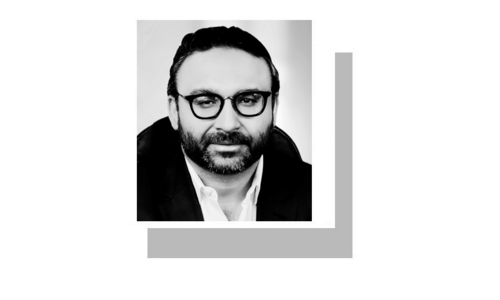
Tanzara Gallery’s exhibition ‘Next Nature’, beautifully curated by Aasim Akhtar, features the works of Zahra Jewanjee, Naqsh Raj, and Tahir Ali. The show aims to explore the “tension between abstraction and representation”, and each artist brings a unique vision and expression of this theme through a visual language all their own. However, one element unites their works and brings a sense of coherence to the collection as a whole: the line.
Jewanjee’s work showcases a palette of taupe and rich plum, striking blues and reds, with large geometric shapes forming the abstracted background in her work. Overlaid is the repeated symbol of the line and bird. From a cursory viewing, one might imagine we’re looking at a deconstructed chair in Successors, but we’re also reminded of hieroglyphics and the full circle we’ve travelled with written communication — the modern day emoji. The line, being the foundation of all written communication and expression, asks the viewer to come closer, to ‘read’ the work more deeply.
As Jewanjee explains, “The concept of lines is embodied in the [Sufi] idea of ‘silsala’, which emphasises spiritual lineages and the interconnectedness of all things.” She notes that, to her, the line represents something “full of possibilities.”

For Ali, however, the line takes on a different connotation. Rather than illuminating, the line for Ali is there to censor and conceal. In Untitled, the horizontal lines across the canvas give us the feeling that we’re looking through blinds or a screen on a window. Are we supposed to be seeing what lies beneath, or have we taken on the role of the voyeur?
The distinct bodies of work of three artists are connected through the unique element of the ‘line’
The more we look at this work, the harder it is to identify what is the line, and what is the image beneath — are they actually one and the same after all? Ali is inspired by how we perceive memories, and the elasticity of time — how we build an ‘internal language’ to map our experiences. Perhaps here the lines are purposefully parting, to give us a glimpse into an internal realm where past, present and future is one?
For Raj, the line becomes the frame through which we understand and perceive. As we see in Reignite, and throughout this body of work, the line is stencilled on to the canvas, giving an underlying sense of structure. However, what could have been the repeat bars of a prison become a window into another world, through the addition of coloured lines that have been painstakingly hand-painted.

We’re again reminded of the basic structure of language, as with Jewanjee’s work, this time going back even further in history, to when our ancestors pressed cuneiform script into clay. According to Raj, “a vertical dash is the most primitive form of written expression.” Take a step back, however, and we could be looking at the shelves of an immense library, where each line, like the spine of a book, represents a whole story yet to be read.
We might even take a step further back, and see that the lines as individual marks disappear, forming curious imagery, like the underlying code of a computer programme, unending combinations of ones and zeros, hidden but creating meaning. Past, present and future are all there — if we read between the lines.
And this, perhaps, is the beauty in the curation of ‘Next Nature’, where the simple line connects three distinct bodies of work. It brings us simultaneously our primitive past, our contemporary sophistication and hints at the future. But, for all our complexity, we’re still communicating in ones and zeros.
‘Next Nature’ was on display at Tanzara Gallery, Islamabad, from August 1-10, 2024
The writer is an Australian based in Pakistan. She is an avid enthusiast of contemporary Pakistani art and culture
Published in Dawn, EOS, September 1st, 2024














































Dear visitor, the comments section is undergoing an overhaul and will return soon.